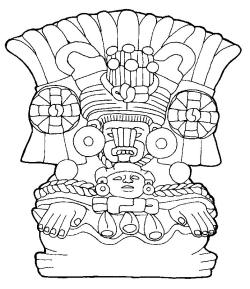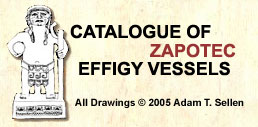| Key: MNA 6-6088 | | Actual Location: National Anthropology Museum, Mexico City, Mexico (exhibited). | | Registration: 6-88 | | Provenance: Inside tomb 104, Monte Albán, Oaxaca. | | Measurements: 42 cm. | | Color: Grey clay with traces of red paint. | | Chronology: Peche 500 - 600 AD | | Click to view Chronology | | Reference: Caso 1938: 76-85, figs. 101, 102; Caso & Bernal 1952: 101, 104, figs. 168, 168bis, 184 bis; Romero 1958: 183, plate XXXVI; Redmond 1983: 171, fig. 59 ; Winter 1990: 127-128, fig. 54; Flannery & Marcus 1996: 210, 212-214, fig. 246. | | Comments: This piece was found behind the carved gravestone that sealed the tomb. It was placed at the feet of the dead looking South. On both sides of the piece, there were four vessels, smaller and plain. In his work of 1938, Caso called this vessel Pitao Cozobi (God of Corn). Tomb 104 was excavated by Caso in 1937 and dated IIIA-IIIB. In my opinion, it represents a high-ranking figure, acting as a priest. As a note of interest, this piece was removed from the tomb by the then President of the Mexican Republic, Lázaro Cárdenas. | | Glyphs: The mask and tied hair correspond to glyph Ñ. Two glyphs 109 in the headdress. | |
| | 
Click to view high resolution in a new window
select this image for review |
